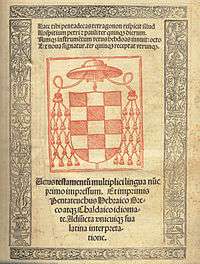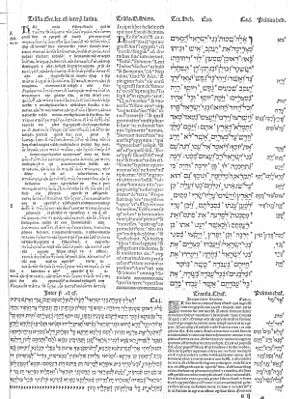Complutensian Polyglot Bible


The Complutensian Polyglot Bible is the name given to the first printed polyglot of the entire Bible, initiated and financed by Cardinal Francisco Jiménez de Cisneros (1436–1517) and published by Complutense University of Madrid. It includes the first printed editions of the Greek New Testament, the complete Septuagint, and the Targum Onkelos. Of the 600 printed six-volume sets, only 123 are known to have survived to date.
History
With the rise of the printing press in the 1450s, the Bible could be distributed much more efficiently. At great personal expense, Cardinal Cisneros acquired many manuscripts and invited the top religious scholars of the day, including Hernán Núñez, to work on the ambitious task of compiling a massive and complete polyglot "to revive the languishing study of the Sacred Scriptures." The scholars met in the city of Complutum (Latin, referred to as Alcalá de Henares), a city near Madrid, at Complutense University. Work on the project began in 1502 under the direction of Diego Lopez de Zúñiga, and continued there for fifteen years.[1] Zúñiga's team of editors included for Greek Demetrius Ducas "of Crete" and his students Hernán Núñez and Juan de Vergara, for Hebrew the conversos Alfonso de Zamora and Pablo de Coronel.
The New Testament was completed and printed in 1514, but its publication was delayed while work on the Old Testament continued, so they could be published together as a complete work.[2] In the meantime, word of the Complutensian project reached Desiderius Erasmus in Rotterdam, who produced his own printed edition of the Greek New Testament. Erasmus obtained an exclusive four-year publishing privilege from Emperor Maximilian and Pope Leo X in 1516. Theodore Beza's Greek NT Text was used primarily, along with Erasmus' Greek NT Text and with various readings from the Complutensian Greek NT Text to form the Textus Receptus published by the Elzevir Brothers in 1633, and Erasmus' later editions were a secondary source for the King James Version of the New Testament. The Complutensian Polyglot Bible was a tertiary source for the 1611 King James Version.
The Complutensian Old Testament was completed in 1517. Because of Erasmus' exclusive privilege, publication of the Polyglot was delayed until Pope Leo X could sanction it in 1520. It is believed to have not been distributed widely before 1522. Cardinal Cisneros died in July 1517, five months after the Polyglot's completion, and never saw its publication.[2]
Contents

The Complutensian Polyglot Bible was published as a six-volume set. The first four volumes contain the Old Testament. Each page consists of three parallel columns of text: Hebrew on the outside, the Latin Vulgate in the middle (corrected by Antonio de Nebrija), and the Greek Septuagint on the inside. On each page of the Pentateuch, the Aramaic text (the Targum Onkelos) and its own Latin translation are added at the bottom. The fifth volume, the New Testament, consists of parallel columns of Greek and the Latin Vulgate. The sixth volume contains various Hebrew, Aramaic, and Greek dictionaries and study aids.[2] For the Greek text, the minuscules 140, 234, and 432 were probably used.
Jerome's Latin version of the Old Testament was placed between the Greek and Hebrew versions, symbolizing the Roman Church of Christ being surrounded and crucified by the Greek Church and the Jews.[3]
A magnificent full size (folio) facsimile edition was published in Valencia 1984-87. It is reproduced for the Bible text (volumes 1-5) from the copy in the Library of the Jesuit Society at Rome; the rare sixth volume with dictionaries has been reproduced from the copy in the Madrid University Library.
The typeface devised for the Complutensian by Arnaldo Guillén de Brocar has been regarded by typographers such as Robert Proctor as the apex of Greek typographical development in early printing, before Aldus Manutius' manuscript-based typefaces took over the market for the next two centuries. Proctor based his 1903 Otter Greek typeface on the Polyglot; the Greek Font Society's GFS Complutensian Greek is likewise based on the Polyglot.
See also
References
- ↑ The new Cambridge modern history, page 124, R. B. (Richard Bruce) Wernham (1906-): "... he and his fellow convert, Pablo de Coronel, were also engaged on the Hebrew and Aramaic sections of the Complutensian Polyglot Bible."
- 1 2 3 Bart D. Ehrman (2005). Misquoting Jesus. San Francisco: HarperCollins. ISBN 978-0-06-073817-4.
- ↑ Ehrman, 76
Further reading
- Lyell, James P. R. (1917), Cardinal Ximenes, Statesman, Ecclesiastic, Soldier, and Man of Letters: with an Account of the Complutensian Polyglot Bible. London: Coptic House, 1917.
- Rummel, Erika. Jiménez de Cisneros: On the Threshold of Spain’s Golden Age. Tempe, Arizona: Arizona Center for Medieval and Renaissance Studies, 1999.
External links
- Catholic Encyclopedia: Editions of the Bible
- Catholic Encyclopedia "Polyglot Bibles"
- DUKE Magazine
- GFS Complutensian Greek
- Robert Proctor's announcement of his Otter Greek font: A New Fount of Greek Type, Burlington Magazine for Connoisseurs, Vol. 2, No. 6 (Aug., 1903), pp. 358-360
- Blog entry on Complutensian typography
- https://www.wdl.org/en/item/10636/